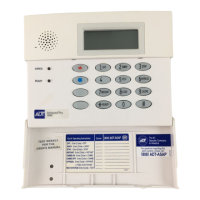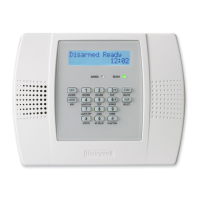3000EN Series: Installation Instructions
3-2
Touchpads
Touchpads are identified by predefined addresses as follows:
Address Touchpad Program Field
16 touchpad 1 • always enabled for partition 1, all sounds enabled. NOTE: First touchpad
17 touchpad 2 • data field *190 is address 16.
18 touchpad 3 • data field *191
19 touchpad 4 • data field *192
20 touchpad 5 • data field *193
21 touchpad 6 • data field *194
22 touchpad 7 • data field *195
23 touchpad 8 • data field *196
To enable touchpads:
1. Set desired address at touchpad (refer to touchpad’s instructions for setting the address).
2. Use data field program mode to enable touchpad addresses, assign a partition, enable sound
options in fields *190-*196 as shown in the table above.
3. If desired, use data field *198 to turn on the display of the partition number.
4. Set the following touchpad-related data fields as required by the installation:
*21 Quick Arm Enable, *23 Forced Bypass, *84 Auto STAY Arm, *176 Lack of Usage Option
5. If using AUI, enable each unit in field *189 and set the AUI devices to the following addresses:
AUI 1 = address 1; AUI 2 = address 2; AUI 3 = address 5; AUI 4 = address 6
Wireless Receiver, Transmitters, and Wireless Keys (keyfobs)
Receiver: Set the receiver’s address to “00” using its DIP switches, then set the following options:
*22 RF Jam Option
†
*24 RF House ID Code (if using wireless touchpads) for each partition
*67 Transmitter Low Battery Report Code
†
*75 Transmitter Low battery restore report code
†
*173 RF Reporting Options
Transmitters: Use *56 or *58 Zone Programming Menu modes to program zone information and
enroll transmitters.
Wireless Keys: Use Wireless Key Programming Templates section of the *58 Expert Programming
mode in Section 5 Zone Programming (page 5-6) to program zone information and enroll each
button of the wireless keys used. Once a wireless key is enrolled, it must be assigned to a user before
it becomes active. See Adding/Deleting Security Codes in Section 12 System Operation (page 12-2)
for the procedure.
Pager Programming
The system can send various reports to up to four pagers. To program pager reporting:
1. Enter the appropriate information in the following data fields
*160, *163, *166, *169 Pager Phone Numbers (for pagers 1-4 respectively)
*161, *164, *167, *170 Pager Prefix Characters (for pagers 1-4 respectively)
*162, *165, *168, *171 Pager Reporting Options by Partition (for pagers 1-4 respectively)
2. Enable Pager Delay, if desired, in field *172 (delays alarm reporting for ALL pagers)
3. Make sure appropriate user open/close pager reports are enabled using the user attribute command
(master code + [8] + user no. + [#] [5] + [1]). Users that perform actions in partition 1 will, if
enabled, attempt to report to all pagers enabled for open/close reporting in partition 1. Users that
perform actions in partition 2 will, if enabled, attempt to report to all pagers enabled for open/close
reporting in partition 2.
4. If using latchkey pager report, define the latchkey report schedule using Scheduling mode (master
code + [#] [6] [4], select event type “03”). System must be armed for the Latchkey report to be sent.
5. If using a function key to manually send a message to a pager, see Function Keys paragraph.
6. If reporting zone alarms and troubles to a pager, use *81 Zone List menu mode to assign the zones
associated with each pager (zone lists 9-12).
† These fields must be enabled for Residential
Fire, UL Residential Burglar Alarm, and UL
Commercial Burglar Alarm installations.

